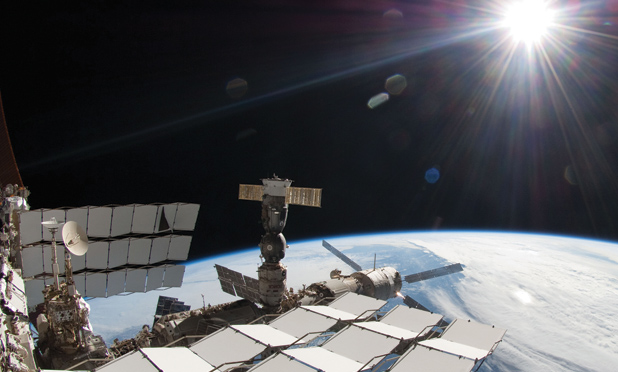To do experiments in space, scientists must carefully think out and prepare their experiments long ahead of time, wait for an available launch window to get their projects up to the laboratories on the International Space Station (ISS), rely in some cases on the expertise of the astronauts to carry out the experiments correctly, and then wait for their results either to be transmitted or, in some cases, to be physically transported back to Earth. Yet, scientists from widely different fields are eagerly awaiting their chance to get their projects into orbit.
Why do they bother? They do it because space affords something very special that a laboratory on Earth doesn’t, and that is its alien environment.
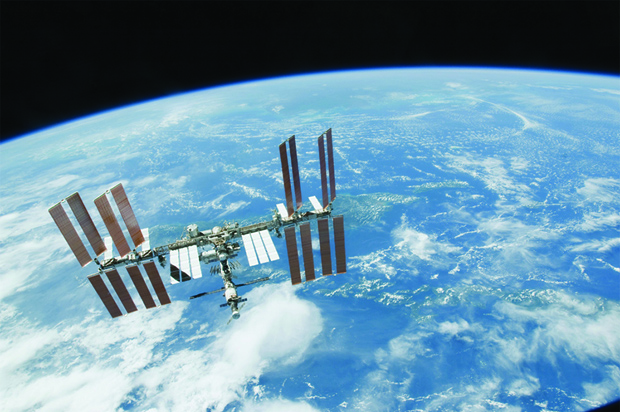
At first blush, a lab in microgravity may seem more of a hindrance than a help—test tubes drifting off, liquids meandering out of containers, and floating wiring or other experimental apparatus tangling—but microgravity itself is one of the principal benefits of space research. The reason is that microgravity presents the opportunity to see things very differently, which, in turn, opens the door to new discoveries that often have important applications back on Earth.
In the microgravity of the ISS, biological systems act in ways that they don’t on the planet. For instance, without gravity tugging them down, astronauts grow an inch or so taller during their first couple of days in space, but at the same time, their skeletal systems begin a long decline, continually losing bone mass day after day. New technologies to combat that decline, as well as studies to determine whether the replaced bone is as good as the original, will provide insight into age-related osteoporosis on Earth and possibly be useful in rehabilitative medicine. Research into bone loss is just one example of the variety of studies involving microgravity’s impact on the human body and how that might be translatable to health on Earth.
On a more fundamental level, researchers are sending up experiments that explore the unusual behaviors of fluids in microgravity. Some of this work is already being used to design a new drug-delivery system. The weightless environment also allows molecules to grow into perfect crystals, permitting previously unseen views of proteins, which often have intricate and exceedingly complex crystalline structures. This gives scientists a much better understanding of the proteins involved in diseases and reveals information critical to battling those illnesses. Genes even behave differently in weightlessness. Researchers are now investigating how microgravity may affect the regulation of genes in bacteria, making them more virulent in the process.
The number and range of experiments being conducted on the ISS at any given time is impressive. Biomedical is a major emphasis, but experiments also cover everything from materials and other physical sciences to meteorology, atmospheric physics, and contained ecological systems.
Why do biomedical research in space? The answer is simple, according to Neal Pellis, one-time head of NASA’s biotechnology and cell biology program and now director of life science for the nonprofit Universities Space Research Association, which facilitates off-the-planet experimentation. “When we go to space and do biomedical experiments there, we force terrestrial life to adapt to this new environment. By doing so, it reveals numerous underlying mechanisms that we haven’t seen before, so just by virtue of the basic science, it’s an exploration treasure trove waiting for discovery.”
The Center for the Advancement of Science in Space (CASIS) expects several areas to draw particular interest in the coming years. CASIS manages the ISS U.S. National Laboratory, which is reserved for experiments conducted by U.S. companies and academic institutions seeking to use space for Earth benefits. One area is stem-cell research, because microgravity permits better formation of three-dimensional tissues and improved differentiation of many stem-cell types. An entire suite of stem-cell experiments are planned to head to the ISS U.S. National Laboratory through CASIS in early 2015.
Other trends are shaping up, according to Warren Bates, CASIS director of portfolio management. “The areas we think will be of most interest are omics-related studies, drug discovery, and use of the accelerated models of disease that are available on ISS.”
[accordion title=”What Is CASIS?”]
For U.S. researchers interested in using space for Earth benefits, the path to orbit starts with CASIS, which is the lab manager for the ISS U.S. National Laboratory.
In this role, CASIS works with NASA and other partners to help researchers at academic institutions and commercial companies get their projects into space, a process that has been made much less expensive through a new funding model that pays for a huge portion of the expenses related to putting an experiment onto the ISS. “The CASIS mission is to expand the use of the ISS U.S. National Laboratory to develop groundbreaking new products, research, and technology for the benefit of humankind,” says Duane Ratliff, chief operating officer of CASIS, which is a nongovernment, nonprofit institution that not only facilitates space experimentation but also does outreach to spread the word about its benefits.
Currently, about half of CASIS projects comes from academic and non-NASA government agencies, and the other half comes from commercial entities. In both cases, the selected projects take advantage of the unique features of the space environment to generate health care advancements and related product development. This fits well with the U.S. Congress’s decision in 2005 to designate 50% of the nation’s ISS resources to research with Earth benefits.
Biomedical experiments make up much of the work in the U.S. National Laboratory. Since its inception in 2011, CASIS has sponsored or supported 26 biomedical-related investigations on the ISS for terrestrial benefit, contributing more than US$5 million in grant funding. That includes research originating in the commercial sector, according to Warren Bates, CASIS director of portfolio management. “In the coming years, I expect to see commercial companies noticing the value brought to their competitors through the use of the ISS, thereby accelerating commercial demand to launch research projects through CASIS.”
Adds former astronaut Gregory H. Johnson, who is president and executive director of CASIS, “We are looking forward to facilitating additional research on the ISS that will continue to advance medicine and human health on Earth.”
[/accordion]
Fortunately, U.S. researchers today have CASIS on their side to facilitate the process of putting an experiment into space, notes Gregory H. Johnson, CASIS president and executive director (see “What Is CASIS?”). “The ISS is arguably humankind’s greatest engineering achievement, and CASIS streamlines traditional processes to make it easier and more affordable to conduct science in space for the betterment of life here on Earth.”
Floating Free
With the veil of gravity lifted, many previously hidden processes of cells, tissues, and body systems can come to light and present new possibilities for medical care. Investigations into bone loss and its prevention are perhaps the most well-known studies on the ISS.
That’s because the histology of microgravity-induced and osteoporosis-related bone loss is similar, but the recovery is not, Pellis says. Bone is restored in astronauts once their mission is over, but osteoporosis doesn’t resolve.
That opens the window for informative research studies in space that can address bone loss suffered by astronauts, patients with age-related osteoporosis, and also possibly individuals who are wheelchair-bound or who have spinal-cord injuries that prevent ambulation, according to Tara M. Ruttley, Ph.D., associate program scientist for the ISS. She explains bone turnover is typical in the human body: Some bone is lost, but bone is generated to replace it. During extended space travel, however, the astronauts lose bone faster than they make it. “Because they’re not using their bones to help hold them up against gravity, they actually lose bone mass at a rate of about 1–2% per month, so it’s really ‘use it or lose it,’” she says. As a comparison, postmenopausal women lose bone mass at a rate of 1–2% per year.
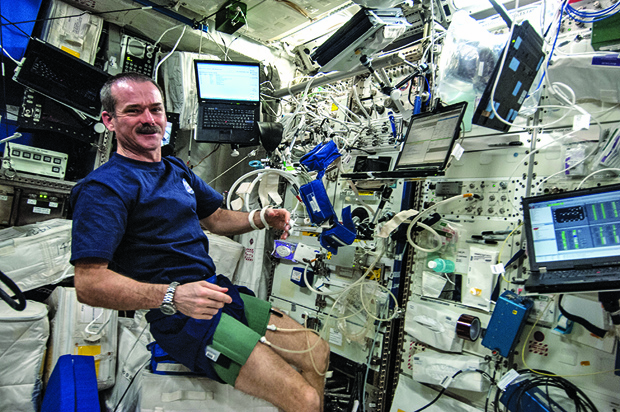
A recent space study, however, showed that astronauts who followed the prescribed space diet, took the recommended dose of vitamin D, and performed a regularly scheduled exercise routine using the Advanced Resistive Exercise Device, which was added to the ISS in 2008 and generates simulated loads of up to 600 lb, were able to maintain their bone mineral density [1], she says. Additional ground studies are now planned that will employ advanced imaging to determine the quality of the restored bone.
In the end, Ruttley adds, “What we learn about bone loss in space is probably a good guide for what we should be doing to mitigate bone loss on Earth.”
Perfect Proteins
Experiments are also under way in space on crystallization. When molecules join a forming crystal on Earth, energy is released, Pellis explains. This heat of crystallization occurs immediately over the top of the crystal as it’s forming, causing a convective feed, with cold coming up from the bottom and heat streaming off the top. “That disrupts the quiescence of the crystallization process,” he says. “In weightlessness, however, there’s no gravity-driven convection, so the crystal can form in a slow and ordered manner.”
That means that proteins, which are often extremely complex crystals, grow into somewhat expanded and more revealing three-dimensional structures. “If you know the structure of a protein to this degree, you can control it, you can inhibit it, you can activate it, and you can create medicines and other biopharma treatments against certain diseases in which proteins are very active,” Ruttley says.
Improved protein crystallization would be especially useful for certain diseases. The proteins active in cystic fibrosis and Huntington’s disease are two examples. They are so difficult to crystallize on Earth that scientists still haven’t been able to do it. This presents opportunities for researchers to send protein solutions to space, grow crystals there, get them back to their home labs, and investigate whether they’ve grown something that can help advance their research in these areas, Ruttley says.
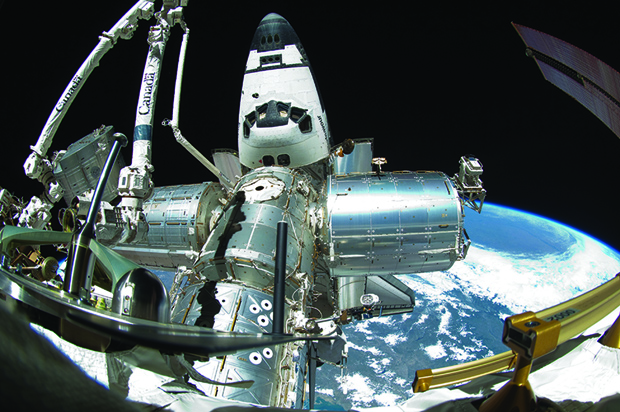
“We have several projects focusing on human disease and drug development already on station and launching within the next year. Some of the most exciting projects involve studying proteins involved in diseases, so we can improve medical interventions by designing more effective, less expensive drugs,” says Bates.
Battling Bacteria
Microgravity has effects on microbes, too, and pathogens are drawing a particular interest from researchers. “When we take bacteria to space, we find that they change their virulence, their capacity to cause disease,” Pellis says. “The latest data indicate that the mechanism by which this virulence is accelerated is one that we’ve never seen before. It’s another example of how space experimentation is revealing new information to us.”
That mechanism, which involves the identification of genes that are regulated differently in microgravity-grown cultures, along with the results from other space experiments, not only widen basic comprehension of how bacteria cause disease, but may also have medical applications.
In fact, studies on Salmonella in space identified changes in the expression of a gene that regulates many bacterial functions, including virulence. While greater expression of this gene has been associated with increased virulence in traditional studies, in space, this gene’s expression goes down, while virulence goes up. Based on these and other unique responses of Salmonella to space flight, researchers applied this knowledge in a spaceflight experiment to benefit vaccine research that actually uses Salmonella in a positive way to help vaccinate people against a variety of diseases on Earth [2].
Many other microbes are under study in space with hopes of finding additional vulnerabilities, Ruttley says. “Understanding these heretofore unseen mechanisms allows us a new target so we can develop more effective antibiotics for use on Earth.”
Pinpoint Drugs
Another exciting area that has its roots in space experimentation is microencapsulation. “This is a method by which you can create tiny microballoons and fill them with antitumor drugs or any other kind of agents that are helpful in treating cancer, and you can directly inject them into cancerous tumors, which mitigates some of the effects of systemic chemotherapy,” Ruttley says. Microencapsulation technology has been around since the 1970s, but it hasn’t reached its full potential yet, she says. In 2002, a team of researchers sent up an experiment to the space station that took advantage of some of the changes in fluid behavior that occur in zero gravity, and they were able to get two immiscible fluids to actually mix together in space.
From that result, the researchers’ work progressed on the ground, and they created a device that mimics what they saw in microgravity and can now mass-produce microballoons [3]. Ruttley adds, “They’ve treated laboratory rats with these microballoons and reported seeing an increase in effectiveness of about 30%.
The applications for microencapsulation go beyond cancer treatment, Pellis notes. “Once you have drugs and other agents encapsulated in microballoons, which are smaller than a red blood cell and can course through the system, you can use them for a number of different things. You can fill them with contrast agent for certain scanning procedures, for instance, or you can design them so you can put two different kinds of drugs—one that’s water-soluble, and one that’s fat-soluble—inside. This is a very interesting time for this area.”
Answers Await
Two other intriguing areas in space research include immunity and cognition changes that have been observed in long-term astronauts. As more crewmembers spend increasingly long periods in space, including a planned one-year manned mission to the ISS in 2015, more data are becoming available about the effects of long-term space travel on human body systems. “It appears that the immune system declines, but we don’t know what exactly is the basis of that decline,” Pellis says. Through monitoring and experimentation, however, he believes researchers will gain new insights into the underlying mechanisms of immunity, which will have applications for noninherited immune diseases, such as AIDS, that result from a virus or other secondary cause.
The identification of come-and-go lapses in cognitive ability in space may also have relevance on Earth. The changes astronauts experience include slowed-down processing. In other words, they might know the answer to a challenging question but have trouble articulating it or writing it down, Pellis says. Some biomedical experts have proposed that the cognitive diminishment is simply a product of insufficient sleep, but studies are suggesting that something more fundamental is going on, Pellis says. “I don’t think anybody can give you a good answer on what’s causing it, but we need those good answers.”
Possible causes for the transient cognitive lapses are the microgravity environment, the isolation of space travel, and the increased radiation in orbit. “If it’s radiation, that’s an issue because we’re entering an era now where we’re going to be treating more and more cancer patients with radiation at a proton facility, which produces energy levels that are more akin to what you see in space than what you see on the ground,” Pellis says. “We really need to know more about how this new big gun in the armamentarium against cancer affects human biology.”
Ready for Launch
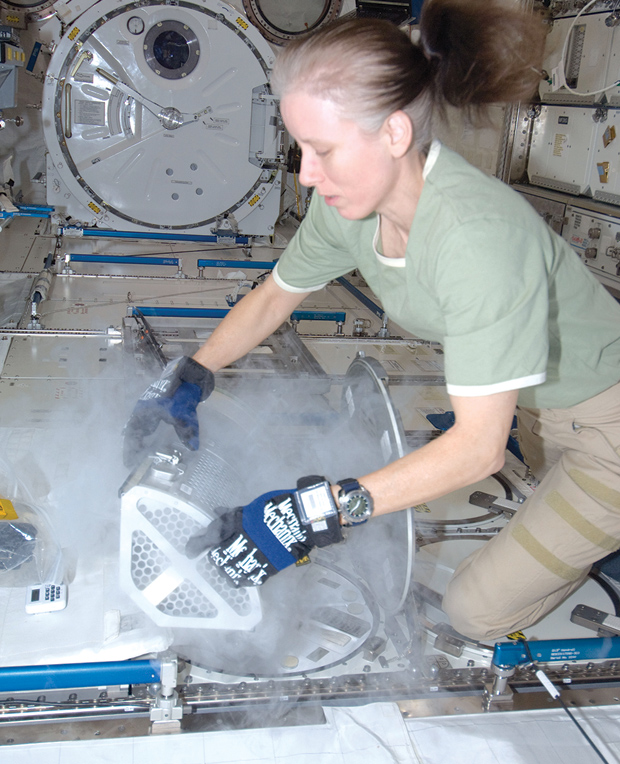
As more researchers have begun to appreciate the possibilities posed by experimentation in the unique environment of space, the variety of projects has broadened and is continuing to do so. New technologies are also emerging.
One example of these technologies is the mammogram. The diagnostic software used in mammograms is image-analysis software originally designed as a temporary fix for the Hubble Space Telescope. The software was used to process the degraded images that the Hubble was taking in its early phase and render them usable and was later co-opted by a mammography manufacturer, says Pellis. “So when someone in the medical field says to me, ‘I don’t really need the space program for anything,’ all I have to do is ask one question: ‘Did you order a mammogram today?’”
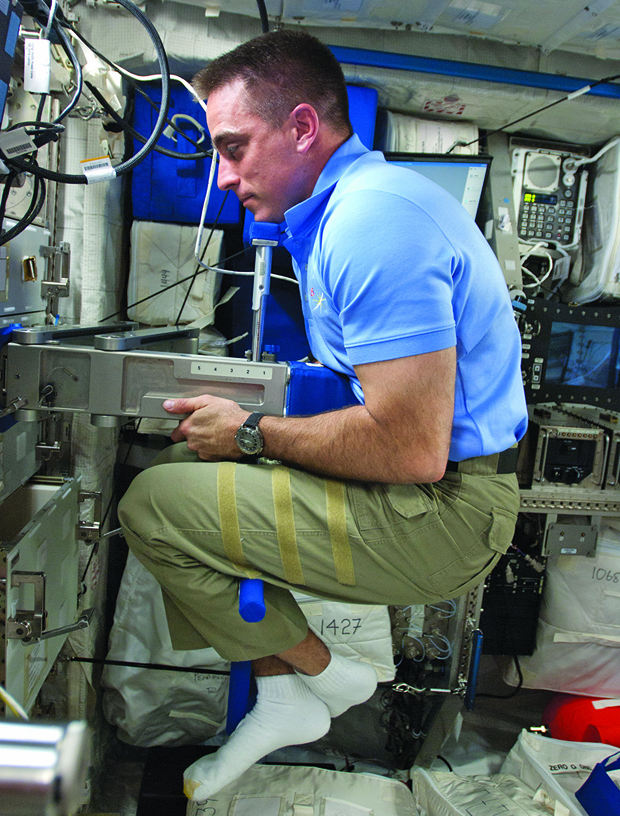
Telemetry was another outcome of space travel. Telemetry was designed for the Apollo space program back in the 1970s, according to Pellis. The NASA ground crew needed to monitor astronaut health in near-real time, which required the wireless transmission and reception of that data. Once physicians saw the capability and realized its potential, they essentially demanded it for their patients, he says, and medical telemetry on Earth made its way into the clinic shortly afterward.
Approximately 25% of long-duration astronauts experience visual impairments. On Earth, the cause of this particular type of impairment is an elevation in intracranial pressure, and it is diagnosed with a lumbar puncture. In space, performing a lumbar puncture is not a pragmatic option. This dilemma has “stimulated about a half-dozen realistic noninvasive ways to assess intracranial pressure,” Pellis says. “And from that, I suspect that, in the next five years, at least one or two of those technologies will advance and make their way into clinical use.”
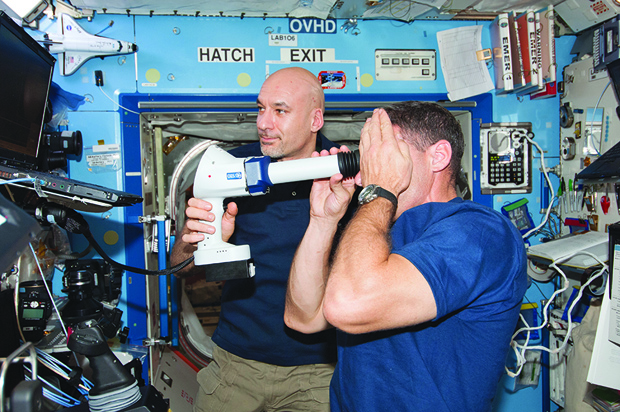
Cyberphysical systems will also be coming soon, according to Clifford Dacso, M.D., chief executive officer of the Houston-based nonprofit Institute for Collaboration in Health, which is working closely with CASIS, and professor of molecular and cell biology and medicine at Baylor College of Medicine as well as Hugh Roy and Lillie Cranz Cullen Professor at the University of Houston College of Technology. A cyberphysical system is a combination of sensors, decision-making software, and robotic devices that serve as stand-ins for some functions currently performed by human beings. An example of a cyberphysical system might be an in-home assisted care machine that monitors elderly patients and administers medicine when needed. He explains, “Cyperphysical systems are essentially human–machine interfaces that make use of multiple inputs to improve decision making. On Earth, the sheer bulk of the machines is limiting, but in a microgravity environment, that is not an issue.”
This barely scratches the surface of the new technologies, treatments, and fundamental understanding of biology that await discovery. “These are just a few interesting things out of the billions of interesting things that we have a chance to look at in space,” Dacso says.
He adds, “So why space? It’s unique. It’s so unique that there’s nothing like it on Earth. And you can quote me on that.”
References
- S. M. Smith, M. A. Heer, L. C. Shackelford, J. D. Sibonga, L. Ploutz-Snyder, and S. R. Zwart, “Benefits for bone from resistance exercise and nutrition in long-duration spaceflight: Evidence from biochemistry and densitometry,” J. Bone Mineral Res., vol. 27, no. 9, pp. 1896–1906, Sept. 2012.
- NASA. Recombinant Attenuated Salmonella Vaccine (RASV)—01.09.14. [Online].
- T. Ruttley. (2012, Dec. 4). Cancer treatment delivery. [Online]. NASA.



